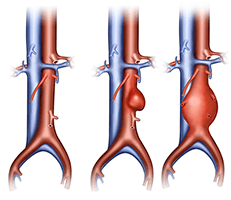Aneurysms Specialist

Acadiana Vascular Clinic:
Vein Center of Louisiana
Lafayette, LA

Acadiana Vascular Clinic:
Vein Center of Louisiana
Lafayette, LA
Aneurysms Q & A
What is an abdominal aortic aneurysm?
An abdominal aortic aneurysm (AAA) is a weakened area of the aorta, which expands and bulges. The aorta is the largest artery of the body. The abdominal aorta is the portion of the aorta that runs through the abdomen and supplies blood to the lower part of the body.
An aneurysm could balloon out and rupture, causing internal bleeding and possibly death. An AAA also places you at higher risk for blood clots, which can travel to your lower extremities or organs.
AAA is a serious condition, but with early detection and proper care, it can be treated or resolved.
 What are symptoms of an abdominal aortic aneurysm?
What are symptoms of an abdominal aortic aneurysm?
In the early stages of an AAA, there are no symptoms. Once your AAA develops, you may experience symptoms such as:
- A pulsing sensation in your abdomen
- Lower extremity pain or discoloration
- Slow-healing wounds on legs and feet
- Dull, deep pain in the back or abdomen
If you have severe pain, especially combined with sudden dizziness, weakness, or loss of consciousness, your abdominal aortic aneurysm could be close to bursting, or has burst.
Who is at risk for an AAA?
You may be at higher risk for an abdominal aortic aneurysm if you have conditions such as heart disease, high blood pressure, or atherosclerosis — hardening of the arteries. You may also be at risk if you:
- Are male
- Have a family history of AAA
- Smoke
- Have a health history of other types of aneurysms
- Are over 60
If you have several risk factors, it’s especially important that you have regular screenings for abdominal aortic aneurysm.
How is an AAA treated?
When an abdominal aortic aneurysm is diagnosed, your provider at the Vein Center of Louisiana creates a treatment plan based on the degree of severity and your symptoms. There are three main approaches to care:
Watchful waiting
Regular checkups every 6-12 months, with lifestyle changes to reduce your risk factors.
Open aneurysm repair
A surgical repair may be needed to place an aortic graft, to strengthen and repair the site.
Endovascular stent graft
A less invasive approach that is used to strengthen and repair the site.
Your provider helps to determine the best approach to treating and curing your AAA.
For screening and treatment for an abdominal aortic aneurysm, call or request an appointment online with the Vein Center of Louisiana. The practice serves those in Lafayette, Lake Charles, Alexandria, and the surrounding areas.
What is an aneurysm?
An aneurysm is a dilation or ballooning of the blood vessels in an area that become weakened. An aneurysm usually develops in arteries in the belly, behind the knees, or the brain.
How do you develop an aneurysm?
Aneurysm develops when the wall of the blood vessels become weakened. Aneurysm tends to run in family and genetics is one of the risks factors. Other risk factors include uncontrolled high blood pressure and smoking.
What is an EVAR?
EVAR, endovascular aneurysm repair, is a minimal invasive procedure to repair abdominal aortic aneurysm (aneurysm in the aorta which is the largest blood vessel in the abdomen) with stents. Majority of patients stay in the hospital overnight.
What is an open aneurysm repair?
Open aneurysm repair is surgical procedure in which the surgeon makes an incision on the abdomen to repair the aneurysm with a prosthetic graft. This procedure requires patients to stay in the hospital for 4-7 days and these can include monitoring in the intensive care unit.
What are risk factors for developing an aneurysm?
Risks factors of developing aneurysm including family history of aneurysm, smoking, older age, high blood pressure. If your parent(s) has an aneurysm, this puts you at higher risk of developing an aneurysm.
Do aneurysms always require surgery?
All aneurysms will eventually require surgery. If the aneurysm is small, your surgeon will monitor the aneurysm until it gets larger. Small aneurysms in the belly can be watch and the risk of rupture is lower versus of risks of surgery for small aneurysms.
How are aneurysms diagnosed?
Aneurysms are usually diagnosed on screening ultrasound for patients 65 years old or greater and if they are smoker or former smoker or CT scan ordered by your doctors to evaluate for other medical issue.
What are the restrictions after aneurysm surgery?
Restrictions after aneurysm surgery depend on the type of procedure you are getting, EVAR or Open aneurysm repair. Patients have minimal restrictions after EVAR and can resume normal activities the day after the procedure. For open aneurysm repair in the belly, during the recovery period patients are not to take bath (shower is okay) if there are staples on the incision, no heavy lifting for first couple of months and no driving when on pain medications.

 What are symptoms of an abdominal aortic aneurysm?
What are symptoms of an abdominal aortic aneurysm?